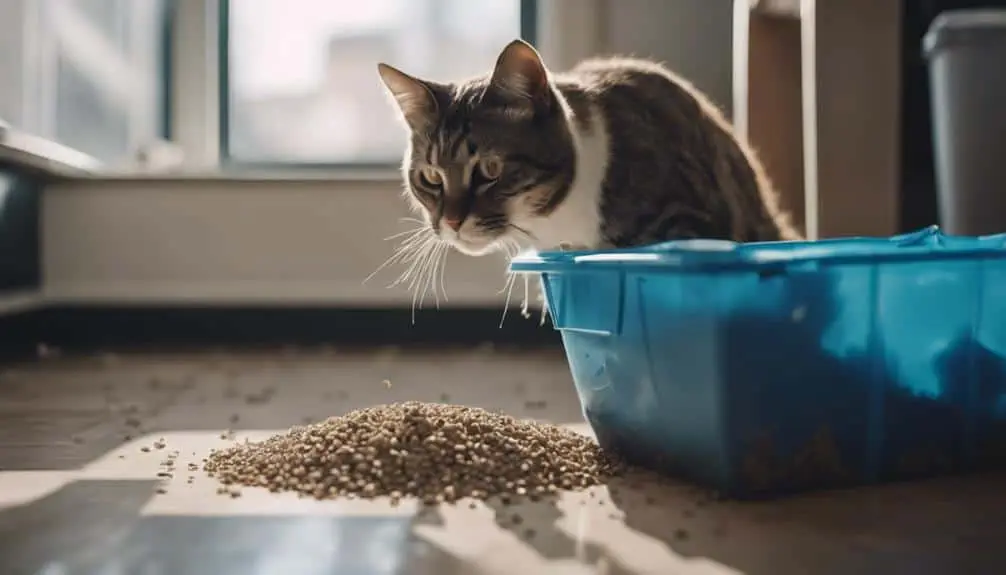The Best Fluffy Pancakes recipe you will fall in love with. Full of tips and tricks to help you make the best pancakes.

If you've ever felt the frustration of your cat rejecting a new litter, you're not alone. But fear not, as there are three simple steps that can make this transition smooth and stress-free for both you and your feline companion.
By following these straightforward guidelines, you can ensure a successful switch that keeps your cat content and your home odor-free.
Key Takeaways
- Gradually increase new litter ratio over a week for smooth transition.
- Monitor cat's behavior and adapt based on signs of stress or confusion.
- Keep litter box clean and inviting to encourage acceptance.
- Consult a vet if cat shows health concerns or persistent refusal.
Preparation for Litter Switch
To begin preparing for the litter switch, gather all the necessary supplies such as new litter, a clean litter box, and a scoop for the transition.
It's crucial to clean the litter box thoroughly to eliminate any old residue or odors before adding the new litter. This step ensures a fresh and inviting space for your cat.
Make sure you have enough new litter to gradually replace the old litter over the transition period. This gradual change helps your cat adjust more comfortably.
Place the new litter box in a quiet and accessible location. A peaceful environment encourages your cat to use the new litter box promptly.
Familiarize your cat with the new litter box and litter by allowing them to explore it beforehand. This step helps your cat feel comfortable with the upcoming change and makes the transition smoother.
Transitioning to New Litter
Gradually mix small amounts of new litter with the old litter each day when transitioning your cat to a different litter type. Cats are sensitive to changes, so a gradual transition is essential for their comfort and acceptance of the new litter. To ensure a successful switch, consider the following steps:
- Monitor Your Cat: Keep an eye on your cat's behavior during the transition period. Look for any signs of stress or discomfort as they adjust to the new litter. If you notice any issues, slow down the transition process to make it easier for your cat.
- Increase New Litter Ratio: Over the course of about a week, gradually increase the amount of new litter in the litter box while decreasing the old litter. This slow adjustment helps your cat become familiar with the new texture and scent.
- Maintain a Clean Litter Box: It's important to keep the litter box clean and inviting. Regularly clean the box to ensure your cat feels comfortable using the new litter. A clean environment will encourage your cat to embrace the change more readily.
Monitoring Your Cat's Adjustment
Transitioning your cat to a new litter type requires careful monitoring of their adjustment to ensure their comfort and acceptance of the change. Start by observing your cat's litter box habits daily to detect any deviations in behavior. Look for signs of stress or confusion, such as avoiding the litter box or unusual toileting patterns.
Note whether your cat immediately adapts to the new litter or shows hesitation in transitioning from the old one. Keep a record of how your cat interacts with the new litter compared to the previous type. Be patient during this process and allow your cat time to adjust comfortably to the new litter.
If you notice any concerning health issues or persistent refusal to use the new litter, consult your veterinarian for advice. Remember, monitoring your cat's adjustment is crucial for a successful switch to a different litter type.
Frequently Asked Questions
How Do You Switch Cats to New Litter?
To switch your cat to new litter, consider their litter preferences. Gradually introduce it, blending scents and adjusting textures. Monitor behavior, offer positive reinforcement, and minimize disruptions. Provide multiple options, observe feline reactions, and ensure proper litter box placement.
How Do You Change Cat Litter Suddenly?
When changing cat litter suddenly, remember to proceed with caution. Gradual transition helps prevent stress and accidents. Consider odor control, clumping vs. non-clumping, environmental impact, dust control, scent preferences, multi-cat households, tracking prevention, budget-friendly options, and health implications.
Do Cats Get Upset When You Change Their Litter?
When altering litter, cats can get upset due to their sensitivity. Feline reactions may include avoiding the box or perching oddly. Slow transitions help minimize stress. Monitoring behavior is vital for their comfort and health during changes.
Will My Cat Use the Litter Box if I Change Litter?
Your cat may adjust to new litter with a gradual transition. Monitor behavior for acceptance. Keep the box clean with preferred texture and odor control. Watch for health concerns. Encourage use with positive reinforcement during this period.
Conclusion
In conclusion, transitioning your cat to a new litter can be a smooth process if done gradually over six days. By following the simple steps outlined and monitoring your cat's adjustment, you can help ensure a successful switch without any issues.
Remember to consult reputable sources for guidance and always prioritize your cat's comfort and well-being throughout the process. With patience and care, your cat will adapt to the new litter in no time.








